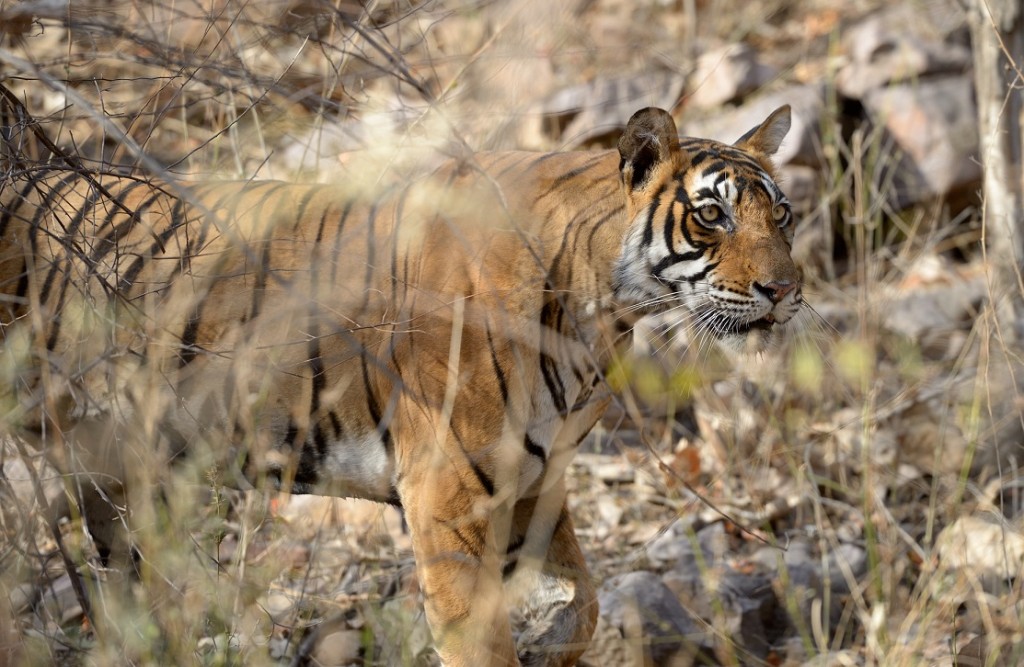Nick Acheson travelled on our 'India - Tiger Direct!' holiday and submitted this entry to our writing competition.
Tiger, India
In the search for a Tiger, a Chital is not a reliable witness. Chital – bless them – are highly strung. They give their piercing alarm call when they see Golden Jackals; sometimes they call when they see Jungle Cats or Wild Pigs; I once even saw a family of Chital approach a waterhole in Kanha National Park and break into a frenzy of alarm-calling, refusing even to take a drink, because there was a Lesser Adjutant Stork in the reeds.
So Chital, though extremely numerous and therefore often the first to spot a Tiger or a Leopard, are not always to be believed. The round-backed Barking Deer is altogether more reliable. Its repetitive rasping bark is a sure sign that a major predator is nearby. Or was nearby. My Tiger-tracking colleagues in Central India often say that the problem with Barking Deer is that, while their alarm calls are more dependable than Chital’s, they tend to go on about the danger, even long after it has passed. So a barking Barking Deer may simply mean that a Tiger was seen here; though by now it is in the next waterhole or crossing the next track through the sal forest.
The most reliable of witnesses – the one whose testimony always gets the conviction – is the Sambar. This is the largest deer of Central India’s forests, with a grey-brown pelt, small, forest-friendly antlers and big, expressive ears. In the parks we regularly visit here – Tadoba, Pench, Satpura, Banhavgarh, Kanha – it is also the deer to hear if Tigers are your target. For Sambar only alarm call when a Tiger, or a Leopard or Asian Wild Dog, is an imminent danger. Where a Sambar is gruffly barking there is a high chance of seeing a Tiger.
Of course, once a Tiger has bagged his Chital, his Wild Pig or his Gaur, he is no longer on the move. In a landscape peopled, depending on where in India you are, by Sloth Bears, by Wolves, by Wild Dogs, by Golden Jackals, by Striped Hyenas, and by Leopards, no Tiger will leave his prey unattended. So having gorged himself a Tiger sits by the kill until he is again hungry. The half-eaten kill attracts birds – Jungle Crows, Rufous Treepies (known in Hindi as Bagh Chiriya, the ‘Tiger Bird’) and vultures. A circling stack of White-rumped or Indian Vultures, with perhaps a Red-headed Vulture among them, is also a likely sign of the presence of a dopey, fat-bellied Tiger below.
Some predictors of Tiger activity dwell in the realms of mystery. In Rajasthan it is said that a Ruddy Mongoose is a portent that within minutes you will encounter a Tiger. Whatever truth there is in this, it is undeniable that the Tiger is woven through the lives, minds and scent receptors of all of the other animals, and people, with whom it shares the forest. Its presence defines the forest and defines the experience of our groups which visit it. In the words of the great Hindu epic the Mahabharata, ‘The Tiger perishes without the forest and the forest perishes without the Tiger.’
Read more about our 'India - Tiger Direct!' holiday.



 Loading search...
Loading search...
